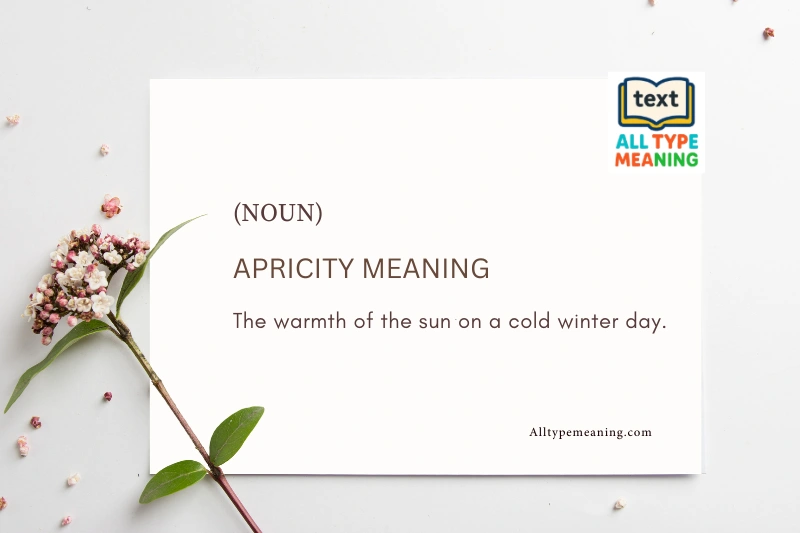Quick Stats About Apricity
| Aspect | Details |
|---|---|
| Word Type | Noun |
| Origin | Latin (apricitas) |
| First Recorded Use | 1600s |
| Current Usage | Rare/Archaic (being revived) |
| Pronunciation | uh-PRIS-i-tee or ay-PRIS-i-tee |
| Syllables | 4 (a-pric-i-ty) |
| Related Language | Latin, English |
| Popularity Trend | Increasing in modern literature |
What is Apricity? Understanding the Complete Meaning
Apricity meaning in English refers to the warmth of the sun during winter. It’s that pleasant, cozy sensation you experience when winter sunlight touches your skin on a cold day. Unlike the harsh heat of summer sun, apricity is gentle, comforting, and deeply soothing.
The word comes from the Latin word “apricitas,” which means “basking in the sun.” Ancient Romans understood this feeling well – they would gather in sunny spots during winter months to enjoy the sun’s warmth, calling this pleasant activity “aprication.”
Why Apricity is Special
What makes apricity unique is its specificity. We have many words for types of rain (drizzle, downpour, shower), but very few words that describe different qualities of sunlight. Apricity fills this gap beautifully by naming something we’ve all experienced but never had the exact word for!
The word captures:
- ☀️ The physical warmth of winter sunshine
- 🧘 The emotional comfort it brings
- ❄️ The contrast between cold air and warm sunlight
- 💛 The joy of finding warmth in a cold season
Apricity Meaning in Hindi
For our Hindi-speaking readers, apricity meaning in Hindi can be translated as “सर्दियों की धूप की गर्माहट” (sardiyon ki dhoop ki garmahat) or “शीतकालीन सूर्य का सुखद ताप” (sheetkaaleen surya ka sukhad taap).
However, like many beautiful English words, apricity doesn’t have a perfect one-word equivalent in Hindi. The closest cultural concept would be enjoying “धूप सेकना” (dhoop sekna) – the act of basking in the winter sun, which is a beloved tradition in North India!
Cultural Connections
The concept of apricity exists across cultures:
- Hindi speakers cherish winter mornings when families gather to enjoy “सर्दी की धूप” (sardi ki dhoop)
- Japanese have “komorebi” for sunlight filtering through trees, showing similar linguistic poetry
- Scandinavian cultures deeply value winter sunlight, though they don’t have an exact equivalent word
This shows that while the English word may be rare, the experience it describes is universal! 🌍
Apricity Meaning in Other Languages
| Language | Meaning of Apricity |
| English | The warmth of the sun in winter |
| Hindi | सर्दियों में सूरज की गर्माहट (Sardiyon mein suraj ki garmāhat) |
| Malayalam | ശീതകാല സൂര്യനിന്റെ ചൂട് (Shītakāla sūryaninte chūṭ) |
| Bengali | শীতের দিনে সূর্যের উষ্ণতা (Śīter dine sūryer uṣṇatā) |
| Marathi | हिवाळ्यात सूर्याची उब (Hivālyāt sūryāchī ub) |
| Tamil | குளிர்காலத்தில் சூரியனின் வெப்பம் (Kuḷirkālaththil sūriyanin veppam) |
| Nepali | जाडो महिनामा घामको तातोपन (Jāḍo mahinā mā ghāmko tātopan) |
| Spanish | Calidez del sol en invierno |
| Punjabi | ਸਰਦੀ ਵਿੱਚ ਸੂਰਜ ਦੀ ਗਰਮੀ (Sardī vich sūraj dī garmī) |
| Urdu | سردیوں میں سورج کی حرارت (Sardiyoñ mein sūraj kī harār |
How to Use Apricity in a Sentence: Practical Examples
Learning apricity in a sentence helps you understand its proper usage. Here are multiple examples showing different contexts:
Simple Everyday Examples
- “I sat by the window, enjoying the apricity on this cold December morning.” ☕
- “The cat found a patch of apricity on the carpet and curled up for a nap.” 🐱
- “Nothing beats the apricity you feel during an afternoon walk in January.”
- “She closed her eyes and smiled, feeling the apricity warm her cheeks.”
Literary and Descriptive Uses
- “The park bench offered perfect apricity – cold wind at your back, warm sun on your face.” 🪑
- “Children gathered in the schoolyard, their faces turned toward the apricity like sunflowers.”
- “He described his grandmother’s garden as a place of apricity and peace during winter months.”
- “The photographer captured the apricity beautifully – golden light on frost-covered grass.”
Poetic and Emotional Context
- “After weeks of gray skies, the apricity felt like a gift from nature itself.” 🎁
- “Her letter spoke of apricity and hope – small warmths in difficult times.”
- “The mountain cabin was designed to maximize apricity through its south-facing windows.”
- “Finding apricity in winter reminds us that even cold seasons hold moments of warmth.”
These examples show that apricity works well in:
- ✍️ Creative writing and poetry
- 📖 Descriptive narratives
- 💬 Casual conversation about weather
- 🎨 Artistic and emotional expressions
The History and Etymology of Apricity
Understanding where apricity comes from makes the word even more meaningful. Let’s trace its journey through time:
Ancient Roman Origins
The word apricity entered English in the 1620s, borrowed directly from Latin “apricitas.” Romans used this word frequently because:
- They built “solaria” – special sun-rooms for winter
- They scheduled activities around warm, sunny hours
- They considered sunbathing a form of health therapy
- Winter sunshine was valued for both physical and mental wellbeing
The Word’s Journey Through Time
1620s: Apricity first appears in English texts, used by scholars and writers who knew Latin.
1800s-1900s: The word gradually fell out of common use as English vocabulary changed and simplified.
2000s-Present: Revival! Social media, word-lovers, and writers have rediscovered apricity, sharing it as a “lost beautiful word.”
Why Did Apricity Disappear?
Several factors contributed to apricity becoming rare:
- 📉 Language simplification during industrialization
- 🌍 English speakers preferred simpler phrases like “winter sunshine”
- 📱 Less emphasis on nature-specific vocabulary
- ⏰ Faster-paced communication reduced poetic language
The Modern Revival
Today, apricity is experiencing a comeback! Thanks to:
- Social media word enthusiasts
- Writers seeking unique vocabulary
- Growing appreciation for nature
- Interest in mindfulness and simple pleasures
- Books and blogs about “forgotten beautiful words”
Why You Should Use Apricity in Your Vocabulary
Adding apricity to your word collection offers several benefits:
For Students and Learners
- 📚 Enriches vocabulary: Shows depth in language understanding
- ✏️ Improves writing: Adds precision and poetry to essays
- 🎓 Impresses teachers: Demonstrates wide reading and curiosity
- 🗣️ Enhances expression: Helps describe experiences more accurately
For Writers and Poets
- 🖋️ Creates vivid imagery: One word paints a complete scene
- 💭 Evokes emotion: Readers instantly understand the feeling
- 🎨 Adds sophistication: Shows linguistic craftsmanship
- ⭐ Stands out: Rare words make writing memorable
For Everyday Communication
- 😊 Connects with nature: Helps you notice and appreciate small joys
- 💬 Starts conversations: People love learning new words!
- 🧠 Exercises mind: Learning new words keeps brain active
- 🌈 Adds beauty: Makes language more colorful and expressive
Practical Tips for Using Apricity
When to use it:
- In creative writing and poetry ✍️
- When describing winter experiences 🌨️
- In nature or travel blogs 🏔️
- During weather-related conversations ☀️
When NOT to use it:
- In highly formal business documents 📄
- When your audience may not understand (unless you explain)
- When simpler words would be clearer
- In urgent, practical communication
Remember: The goal is clear communication! Use apricity when it adds value, not just to sound fancy. 😊
Similar Words and Related Concepts
While Apricity Meaning is unique, knowing related words helps understand it better:
Temperature-Related Words
- Warmth: General feeling of heat (not specific to winter sun)
- Radiance: Quality of shining light (visual, not temperature)
- Heat: Higher temperature (usually too strong for apricity’s gentle meaning)
- Glow: Soft, warm light or feeling
Sun-Related Terms
- Sunshine: General word for sunlight (any season)
- Sunbeam: Ray of sunlight (visual focus)
- Insolation: Technical term for solar radiation exposure
- Heliotropism: Turning toward the sun (botanical)
Seasonal Words
- Hibernal: Relating to winter
- Brumous: Foggy, wintry (opposite feeling to apricity!)
- Niveous: Snow-like, snowy
- Gelid: Extremely cold
The Apricity Experience
Words that capture similar feelings:
- Cozy: Comfortable warmth indoors 🏠
- Snug: Warm and comfortable, protected
- Toasty: Pleasantly warm (more informal)
- Basking: Lying in warmth (the action, not the feeling)
None of these words perfectly capture what apricity does – that specific winter sun warmth on your skin! 🌟
Conclusion:
The apricity full form refers to the warmth of the sun in winter, providing a cozy and comforting feeling on chilly days. Derived from the Latin word apricitas, it encapsulates an emotion that many of us feel but seldom have a specific term for. Although it is uncommon, apricity is becoming more popular due to its poetic allure.
Familiarity with this word enhances one’s vocabulary, assisting students, writers, and professionals in articulating experiences more vividly, while also adding a touch of elegance to writing, discussions, and creative endeavors. Discover our ultimate guide to the intriguing meaning of bildungsroman meaning.
Frequently Asked Questions
1. Is apricity a real English word?
Answer: Yes! Apricity is a real English word from the 1620s, borrowed from Latin “apricitas.” While rare today, it’s found in the Oxford English Dictionary and is experiencing a modern revival among word lovers and writers. 📖
2. How do you pronounce apricity correctly?
Answer: Pronounce it as uh-PRIS-i-tee or ay-PRIS-i-tee (both acceptable). The stress is on the second syllable: a-PRIC-i-ty. It rhymes with “electricity.” 🗣️
3. What’s the difference between apricity and sunshine?
Answer: “Sunshine” is general sunlight in any season. Apricity specifically means the warmth of winter sun on your skin – that cozy contrast of cold air with warm sunlight on your face. It’s what you feel, not just what you see! ☀️❄️
4. Can I use apricity in formal writing?
Answer: Yes, for creative writing, poetry, and descriptive essays. For academic papers, use it if relevant (literature, linguistics, nature topics) with a brief explanation. Avoid it in technical/scientific papers – use “winter sunlight” instead. 📝
5. Do other languages have a word like apricity?
Answer: No exact equivalent exists in most languages. Hindi uses “धूप सेकना” (dhoop sekna – basking in sun), Japanese has “komorebi” (sunlight through trees). The concept is universal, but single-word equivalents are rare, making apricity special!
Learn new words, slang, and useful language tips with All Type Meaning!📚

